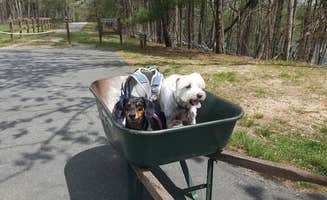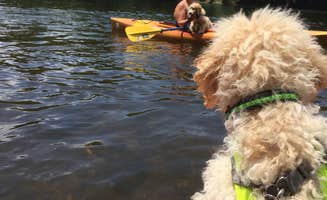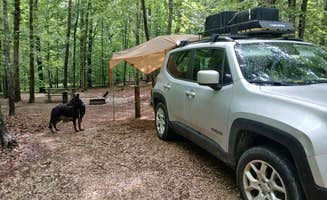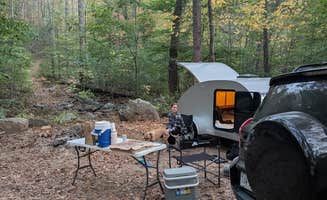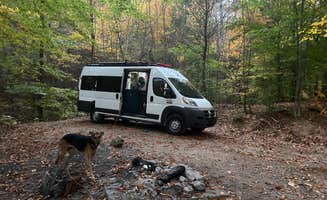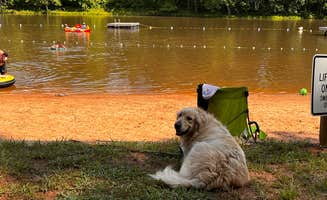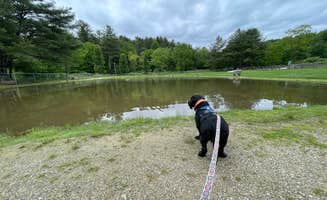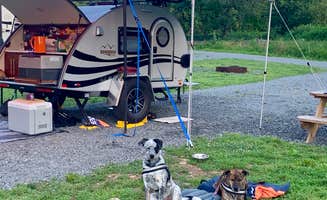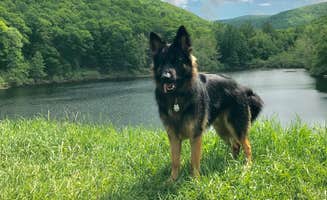James River State Park's camping areas sit about 15 miles from Amherst, Virginia at elevations between 650-800 feet along the James River's northern bank. The region experiences mild springs and falls, with summer temperatures often reaching the high 80s. Several campgrounds near Amherst offer primitive tent sites with riverfront access, while others provide full RV hookups or cabin rentals.
What to do
Hiking trails beyond the park system: Devils Backbone Camp offers easy access to local hiking destinations. "We hiked to Humpback Rocks which is a decent climb, so be prepared, but once you summit, the views are amazing," notes one visitor. The camp serves as a convenient base for exploring the Blue Ridge Parkway trails.
Water activities on multiple waterways: Fishing opportunities abound at Sherando Lake Campground, which features two lakes. "There are two lakes--the lower lake is the largest at 25 acres, and while the beach can get crowded during peak season, it's an easy walk from the campground, with a large swimming area roped off," explains a camper. The upper lake is reserved for fishing only.
Stargazing in designated dark sky areas: Several campgrounds offer exceptional night sky viewing due to minimal light pollution. "This park is part of the Dark Sky Parks Association and if you are into astronomy and stars this is the place to stay," mentions a Red Oak Campground visitor. Some parks even provide telescopes for guests to use.
What campers like
Well-maintained bathroom facilities: Cleanliness stands out as a priority at many campgrounds. At Devils Backbone Camp, one camper notes, "This campground has some of the nicest facilities of any campground I've stayed at." Another camper adds, "The bathhouse is top notch! Squeaky clean with lots of space."
Creek and river proximity: Many tent sites offer direct water access. "Camping along the river at the Canoe Landing Campground is great in the slower seasons. The sites are pretty close together so I'm sure it would be much more cramped when it's busy but it's a beautiful place," shares one reviewer. Several campers mention falling asleep to the sound of flowing water.
Variety of accommodation types: Lynchburg/Blue Ridge Parkway KOA offers multiple options for different camping preferences. "The tent sites were large and shaded. We were right by the fishing pond and it was a short walk to the playground, pool, jump pad, and very clean, private bathrooms," explains a camper. "It stormed our first night, and the raised gravel tent platforms prevented us from flooding."
What you should know
Primitive sites have limited facilities: At Branch Pond, campers should prepare for basic amenities. "Tent sites have permanent holes in the ground and no running water. If you know what you're getting into it would be OK," notes one camper. Some primitive camping areas have pit toilets only.
Reservation requirements vary: Many campgrounds fill quickly during peak seasons. One camper observes, "The only drawback is that many people love this park and it is difficult to get reservations. The window opens six months out and are usually booked for the high season summer months."
Cell service limitations: Connectivity varies significantly between locations. "Cell service and wi-fi are spotty at best, but what do you expect? You are in the middle of the mountains," reports one camper. Some campgrounds offer Wi-Fi at central locations like visitor centers while others have no service at all.
Tips for camping with families
Seek campgrounds with dedicated children's activities: Lynchburg/Blue Ridge Parkway KOA offers extensive programming for kids. "They had activities every day for the kids. As well as lots of unstructured activities. For example, they had a foosball table and a jumping pad. But they also had a 'color a sack' thing where the kids got a KOA canvas tote and access to fabric markers," shares one parent.
Choose sites with playground proximity: Consider location within the campground when traveling with children. "If you have young kiddos, the C loop is closest to the playground," advises one Sherando Lake Campground visitor.
Pack for unpredictable weather: Temperature fluctuations can impact camping comfort. "It was very cold when we were there and we really wished there was a designated 'beach' area on the river (or in a perfect world, a pool)," reports one family. Bringing extra layers and rain gear is advisable even in summer months.
Tips for RVers
Check hookup locations before arrival: Some campgrounds have unusual utility layouts. At Devils Backbone Camp, "The hookups in this area where different than I have ever experienced as the hookups were shared between two sites. If you were on an even number site, this was no problem. However, if you were on an odd number site, you either had to hope you had the length on your water and power lines to run to the opposite side of your rig," explains one RVer.
Bring extra-long hoses and power cords: "For example, we have a small travel trailer and we needed a 30 foot hose. The sewer connection for the odd number sites is on the opposite side of the RV than the electricity and water," advises an RVer about Devils Backbone Camp.
Consider size limitations for certain loops: Loop selection matters for larger vehicles. "The tent only loop dates to this time. Two additional loops have been added with electric sites," notes one camper about Sherando Lake. Most campgrounds specify maximum RV lengths for each area, with some accommodating only smaller rigs under 30 feet.


